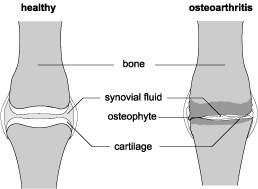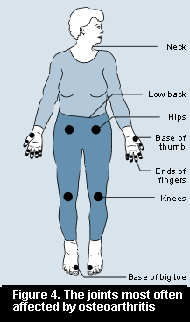 "The
radiological severity of knee osteoarthritis was greater
in the endemic fluorosis group than in controls... [E]ndemic fluorosis
may increase the severity of osteoarthritis in the knees."
"The
radiological severity of knee osteoarthritis was greater
in the endemic fluorosis group than in controls... [E]ndemic fluorosis
may increase the severity of osteoarthritis in the knees."
SOURCE: Savas S, et al. (2001). Endemic fluorosis in Turkish patients:
relationship with knee osteoarthritis. Rheumatology International
21: 30-5.
"Radiographs of the skeleton and bone
scintigraphy showed degenerative osteoarthritis...
Interestingly, laboratory findings, skeletal radiographs and bone
densitometry, gave no indication for abnormalities of bone metabolism
or mineralization. Without bone biopsy we
would have failed the correct diagnosis (of skeletal fluorosis)."
SOURCE: Roschger P, et al. (1995). Bone mineral structure after
six years fluoride treatment investigated by backscattered electron
imaging (BSEI) and small angle x-ray scattering (SAXS): a case
report. Bone 16:407.
"Clinical Phase 1 Fluorosis: Sporadic
pain; stiffness of joints; osteosclerosis of pelvis &
vertebral column. Clinical Phase 2 Fluorosis: Chronic
joint pain; arthritic symptoms; slight calcification of ligaments..."
SOURCE: Department of Health and Human Services. (1991). Review
of fluoride: benefits and risks.
Report of the Ad Hoc Subcommittee on Fluoride. Washington, DC.
"The most frequent symptoms in those
exposed >6 yr were low back pain, painful knee, elbow, and
hip... Analysis of workers' complaints showed no specific
pain or other symptom that we could refer only to fluorosis...The
only characteristic feature would be multiple-joint
involvement in the case of fluorosis. This
would differentitate fluorosis from monoarticular osteoarthritis
(OA), but unfortunately not from multiple-joint osteoarthritis
or rheumatoid arthritis (RA)."
SOURCE: Czerwinski E, et al.
(1988). Bone and joint pathology in fluoride-exposed workers.
Archives of Environmental Health 43: 340-343.
"Degenerative joint changes. Extensive
degenerative changes may occur in patients with fluorine poisoning,
resulting in osteoarthritis. Of the 146 cases, 107 (73%)
had articular changes. Of these 107 cases, 12 were below
30 years of age and 2 were children. In the X-rays of dog's limb
big choints, changes resembling those in humans were seen."
SOURCE: Xu JC, et al. (1987). X-ray findings and pathological
basis of bone fluorosis. Chinese
Medical Journal 100:8-16.
"[I]t is postulated that fluoride activates the calcification
of cartilage...Thus it would be interesting
to investigate the effect of fluoride on the evolution of joint
alterations in rheumatoid arthritis and osteoarthrosis."
SOURCE: Bang S, et al. (1985). Distribution
of fluoride in calcified cartilage of a fluoride-treated osteoporotic
patient. Bone 6: 207-210.
"Crippling fluorosis... is characterized by
dense bones, exostoses, neurologic complications due to bony overgrowth,
osteoarthritis, and ligamentous
calcification."
SOURCE: Riggs BL. (1983). Treatment of osteoporosis with sodium
fluoride: An appraisal. Bone and Mineral Research 2: 366-393.
"[E]xtensive research from India has revealed
severe arthritic changes and crippling neurological complications
even where the fluoride concentration in water naturally is as
low as 1.5 ppm...Even though extensive bone deformities may not
be found on a large scale from fluoride in water at the 1 ppm
concentration, some of the early signs
of the disease, such as calcifications of
ligaments, joint capsules, and muscle attachments, are
likely to occur. Indeed these conditions
are characteristic of osteoarthritis, in which the
formation of microcrystals of apatite (known to be promoted by
fluoride) has now been clearly demonstrated... For
example, Pinet and Pinet described in detail X-ray
changes encountered in skeletal fluorosis in North Africa that
are in every respect identical with those present in the arthritic
spine of the elderly elsewhere."
SOURCE: Waldbott GL, Burgstahler AW, and McKinney HL. (1978).
Fluoridation: The Great Dilemma. Coronado Press, Inc.,
Lawrence, Kansas.
"Studies directed toward correlating fluoride-induced
increases in bone density with non-fatal diseases, such as osteoarthritis,
should be conducted."
SOURCE: Prival MJ. (1972). Fluorides and human health. Center
for Science in the Public Interest, Washington D.C.
"The onset of chronic fluorosis is
insidious and may be confused with chronic debilitating diseases
such as osteoarthritis, trace-element toxicosis,
and trace-element deficiencies."
SOURCE: Shupe JL. (1970). Fluorine toxicosis and industry. American
Industrial Hygiene Association Journal 31: 240-247.
"Whereas dental fluorosis is easily recognized, the skeletal
involvement is not clinically
obvious until the advanced stage of crippling fluorosis...
Such early cases are usually in young adults whose only complaints
are vague pains noted most frequently in
the small joints of the hands and feet, in the knee joints and
in the joints of the spine. These cases are frequent in the endemic
area and may be misdiagnosed as rheumatoid or osteo arthritis."
SOURCE: Singh A, Jolly SS. (1970). Chronic toxic effects on the
skeletal system. In: Fluorides and Human Health. World Health
Organization. pp. 238-249.
"He did not complain of back pain and experienced only minimal
disability from chronic osteoarthritis
that had been present in the right hip for more than 10 years."
(NOTE from FAN: This patient was diagnosed
by the authors as suffering from skeletal fluorosis, although
the authors did not consider the possibility that the fluorosis
and the osteoarthritis were related.)
SOURCE: Gilbaugh JH, Thompson GJ. (1966). Fluoride osteosclerosis
simulating carcinoma of the prostate with widespread bony metastasis:
a case report. Journal of Urology 96: 944-946.
"In general, the metabolic patterns of osteoblasts, ameloblasts,
odontoblasts, and chrondoblasts are sufficiently similar so that
disturbances of cartilage might be expected... To
date, any osteoarthritis observed in fluoride-treated cattle
has been regarded as an unrelated process. However, excessive
remodeling of the subchondral plate and cancellous end of the
bone, such as occurs in osteofluorosis, will eventually lead to
remodeling of the articular cartilage. Excessive cartilage remodeling
leads to osteoarthritis of normal joints. Therefore, both
the mechanical effects of fluoride induced remodeling and the
direct action of fluoride on cartilage cells might alter cartilage.
The fluoride levels and remodeling circumstances necessary to
produce cartilage alteration in cattle - if it occurs - remain
to be established."
SOURCE: Johnson LC. (1965). Histogenesis and mechanisms in the
development of osteofluorosis. In: H.C.Hodge and F.A.Smith, eds
: Fluorine chemistry, Vol. 4. New York, N.Y., Academic press (1965)
424-441.
"The ligamentous calcification [of skeletal fluorosis] is
often periarticular and shows as osteoarthritis
of the spine and hip joints as well as of the sacro-iliac joints."
SOURCE: Kumar SP, Harper RA. (1963). Fluorosis in Aden. British
Journal of Radiology 36: 497-502.
In the early stages of skeletal fluorosis, the "only
complaints are vague pains noted most frequently in the small
joints of hands and feet, the knee joints and those of the spine.
Such cases are frequent in the endemic area and may be misdiagnosed
as rheumatoid or osteoarthritis. Such symptoms
may be present prior to
the development of definite radiological signs. A study of
the incidence of rheumatic disorders in areas where fluoridation
has been in progress for a number of years would be of interest."
SOURCE: Singh A, et al.
(1963). Endemic fluorosis. Epidemiological, clinical and biochemical
study of chronic fluoride intoxication in Punjab. Medicine
42: 229-246.



 "The
radiological severity of knee osteoarthritis was greater
in the endemic fluorosis group than in controls... [E]ndemic fluorosis
may increase the severity of osteoarthritis in the knees."
"The
radiological severity of knee osteoarthritis was greater
in the endemic fluorosis group than in controls... [E]ndemic fluorosis
may increase the severity of osteoarthritis in the knees."